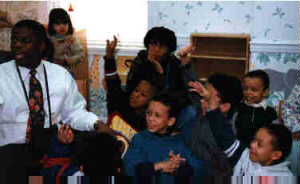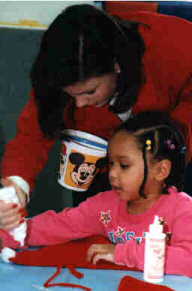

at the Children's Hospital Scottish Rite Center for
Childhood Language Disorders in Washington, DC.
 |
 |
|
at the Children's Hospital Scottish Rite Center for Childhood Language Disorders in Washington, DC. |
Innovative Programs Lead To Success
Tommie L. Robinson Jr., Ph.D.
Director of the Children's Hospital Scottish Rite
Center
The Children's Hospital Scottish Rite Center for Childhood Language Disorders in Washington, DC, found much success in its development of two clinical programs over the summer of 1996. Faced with issues surrounding managed care, lack of staff and increased number of children requesting services, the need for innovative programming led to the development of the Bilingual Parent Education and Training Program and the Summer Fluency Program. A description of each program follows.
Bilingual Parent Education And Training Program
This program was designed to meet the communication needs of preschool children with speech-language difficulties, specifically children from bilingual or primarily Spanish-speaking families. Its purpose developed out of the need to decrease the number of children waiting for therapy and the need to teach parents how to facilitate their children's speech and language skills in light of the Center having few bilingual staff members.
Parents were asked to participate in groups of eight. Each group of parents met for one and one-half hour each week. Sessions were held for five weeks. During the course of the sessions, parents were initially given information on the components of speech and language development. Speech-language pathol- ogists also shared information with parents relative to literacy experiences (types of books to buy and how to use them; the library, etc.), buying toys, creating language activities in home, and so on. The final two sessions of the group meetings were devoted to "hands on" activities in which the professional staff served as a resource for parents as they interacted with their children to facilitate language. During the sessions, the clinicians provided feedback to parents and offered alternatives for communicative interaction. The cultural interaction styles of parents were preserved.
 |
Speech-language pathologist Sharon Netta Curcio shares
in the fun of learning with a child at the Children's Hospital Scottish Rite Center for Childhood Language Disorders. |
The issues of child care and follow-up were also addressed. Volunteers were used to conduct play groups and monitor children's activities while the parents were in session. After the group sessions were completed, the children were placed back on the wait list for therapy. Clinicians then did monthly follow-ups to determine the progress and specific needs of each child.
The Center is considering expanding this program to English-speaking parents, using it as a prerequisite to formal speech-language treatment.
Summer Fluency Program
This program was designed to meet the social and communication needs of adolescents who stutter. The primary participants in the program were those individuals receiving therapy at school but not during the summer months. The unique aspects of this program provided a bridge of different communicative experiences for children who normally would not have been seen for therapy over the summer.
The Summer Fluency Program helped students to maintain an acceptable level of speech fluency during this change in communication partners and in their communication environment. Also, this program created a partnership with public school speech-language pathologists so that gains made during the summer could be pursued during the regular school year.
Participants were seen for individual and group therapy, depending upon their individual needs and speech fluency profiles. During each session, aspects of speech fluency therapy addressed the overall goal of the program, social communication. For example, if a goal focused on having the students be fluent while placing an order in a restaurant, then the specific therapy methods used focused on this goal. All objectives were based on enhancing social communication while maintaining speech fluency expectations.
Adolescent group meetings were held to discuss issues relative to the impact of stuttering on maturity. Participants talked about self-help skills; maintenance of fluency and carryover strategies; social communication; as well as social issues affecting dating, peer interaction, and families.
While students were in group meetings, their parents met to discuss issues germane to their children. The parents established informal relationships among themselves and discussed the social and communicative well-being of their children. Formal discussions, led by the clinician, focused on helping parents understand and accept their children's stuttering.
The final focus of this program was geared towards helping the students continue their fluent communication moments in a variety of speaking situations. Participants were encouraged to demonstrate carryover immediately during the therapy sessions. In addition, some participants were given the opportunity to use their speech fluency strategies in an atmosphere where speech-language pathologists could give frequent and consistent feedback on speech.
The Center is currently reviewing the possibility of continuing support group meetings of adolescents, as well as parents during the school year. The students and their parents expressed an interest in such a service which could compliment the regular school therapy program.